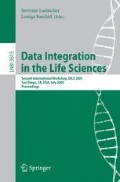Abstract
We often realize that communicating with other colleagues who are studying similar topics helps to identify information relevant to our area of study, which otherwise may not have been found. We wish to accelerate acquisition of collective knowledge in a defined area by identifying specific spheres of inquiry. Such spheres correspond to groups of people who are experts in a field. In this paper we provide a systematic way to gain knowledge from their online search activity, and enable them to organize and share their search findings for further analysis. We have built a prototype system, BioLog, to help biomedical researchers share this implicit knowledge among their peers and store their access patterns into a central system for reuse. BioLog has been deployed it in two labs within TGen as a pilot study. The data has been gathered and analyzed by preliminary text-mining and collaborative filtering methods.
Access this chapter
Tax calculation will be finalised at checkout
Purchases are for personal use only
Preview
Unable to display preview. Download preview PDF.
References
Pubmed by NCBI and National Library of Medicine, http://www.ncbi.nlm.nih.gov/entrez/query.fcgi
Resnick, P., Iacovou, N., Suchak, M., Bergstrom, P., Riedl, J.: An Open Architecture for Collaborative Filtering of Netnews. In: Proceedings of the ACM Conference on Computer Supported Cooperative Work, pp. 175–186. ACM, New York (1994)
Salton, G., McGill, M.J.: Introduction to Modern Retrieval. McGraw-Hill Book Company, New York (1983)
Breese, J., Heckerman, D., Kadie, C.: Empirical Analysis of Predictive Algorithms for Collaborative Filtering. In: Proceedings of the 14 th Conference on Uncertainty in Artificial Intelligence, pp. 43–52 (1998)
Doan, A., McCann, R.: Building Data Integration Systems: A Mass Collaboration Approach. In: IJCAI 2003 (2003)
Browser Helper Objects: The Browser the Way You Want It. Dino Esposito. Microsoft Corporation, http://msdn.microsoft.com/library/en-us/dnwebgen/html/bho.asp
Legendre, P., Legendre, L.: Numerical Eoclogy, 2nd edn. Elsevier, Amsterdam (1998)
Translational Genomics Research Institute (TGen), http://www.tgen.org/
Bar-Joseph, Z., et al.: K-ary clustering with optimal leaf ordering for gene expression data. Bioinformatics 19(9), 1070–1078 (2003)
Getz, G., et al.: Coupled two-way clustering analysis of breast cancer and colon cancer gene expression data. Bioinformatics 19(9), 1079–1089 (2003)
Parsons, L., Haque, E., Liu, H.: Subspace clustering for high dimensional data: a review. SIGKDD Explor. Newsl., 1004, 6(1), 90–105
Devroye, L., Gyorfi, L., Lugosi, G.: A Probabilistic Theory of Pattern Recognition. Springer, New York (1996)
Parsons, L., Haque, E., Liu, H.: Evaluating Subspace Clustering Algorithms. In: Workshop on Clustering High Dimensional Data and its Applications, SIAM International Conference on Data Mining, (SDM 2004) (2004)
Friedman, J.H., Meulman, J.J.: Clustering Objects on Subsets of Attributes. Journal of the Royal Statistical Society Series B 66(4), 815 (2004)
Liu, H., Yu, L.: Toward Integrating Feature Selection Algorithms for Classification and Clustering. IEEE Transaction on Knowledge and Data Engineering, forthcoming
Jain, A.K., Dubes, R.C.: Algorithms for Clustering Data. Prentice-Hall, Englewood Cliffs (1988)
Settles, B.: Biomedical Named Entity Recognition Using Conditional Random Fields and Rich Feature Sets. In: International Joint Workshop on Natural Language Processing in Biomedicine and its Applications (NLPBA), Switzerland (2004)
Author information
Authors and Affiliations
Editor information
Editors and Affiliations
Rights and permissions
Copyright information
© 2005 Springer-Verlag Berlin Heidelberg
About this paper
Cite this paper
Singh, P. et al. (2005). BioLog: A Browser Based Collaboration and Resource Navigation Assistant for BioMedical Researchers. In: Ludäscher, B., Raschid, L. (eds) Data Integration in the Life Sciences. DILS 2005. Lecture Notes in Computer Science(), vol 3615. Springer, Berlin, Heidelberg. https://doi.org/10.1007/11530084_4
Download citation
DOI: https://doi.org/10.1007/11530084_4
Publisher Name: Springer, Berlin, Heidelberg
Print ISBN: 978-3-540-27967-9
Online ISBN: 978-3-540-31879-8
eBook Packages: Computer ScienceComputer Science (R0)

